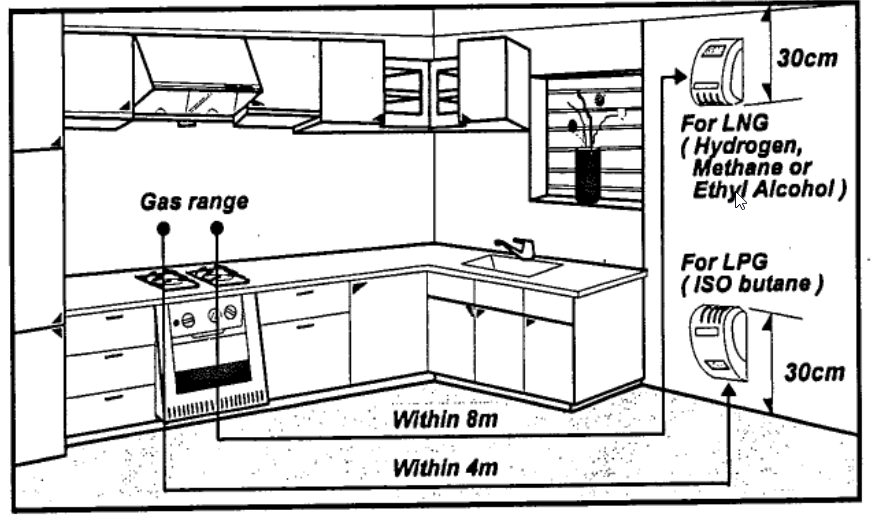Fuel Gas Detection - It’s a Good Idea

Propane and natural gas are both popular fuels when it comes to heating and cooking. However, these fuels present risks. In the event of a leak both can produce a highly flammable vapor cloud presenting an explosion hazard in enclosed spaces. In addition, propane and natural gas are asphyxiants. High concentrations of either gas can displace oxygen in the air and cause asphyxiation.
Since both gases are colorless and odorless leaks can go undetected. As a safety measure, government agencies require utility companies to add an odorant, most often a harmless chemical called mercaptan. Its distinctive sulfur-like, “rotten egg” smell can make leaks easier to detect. However, even with mercaptan, for detection to occur someone must be present. By the time you can smell a threat, it may be too late.
According to the National Fire Protection Association (NFPA), “an estimated average of 4,200 home structure fires per year started with the ignition of natural gas. These fires cause an average of 40 deaths and $54 million in direct property damage per year. In the U.S., local fire departments respond to an average of 340 natural gas or LP-Gas leaks per day, and 125,000 annually with no ignition.” Although gas leaks are much more common than gas ignitions, they can be precursors to devastating events.
One such incident occurred in Farmington Maine on September 16, 2019. A leak was detected within a business when employees reported to work. Due to noticeable odor, the building was evacuated, and emergency personnel responded.
To identify the leak source, a maintenance employee accompanied by several members of the local fire department re-entered the building. While inside, a massive explosion occurred, taking the life of sixty-eight-year-old Farmington Fire Captain Michael Bell, and seriously injuring eight other people. The entire building was demolished.
After extensive investigation, it was determined the root cause of this incident was the failure to properly identify underground utilities prior to digging. Six days prior to the blast, multiple 10-foot posts had been drilled into the ground in the parking lot to protect an outdoor air conditioning unit near the building. An underground propane line between the building and a large propane tank was severed by this digging. The blast also destroyed nearby homes and scattered debris for more than a mile.
This incident serves as a reminder that an underground utility service must be called before excavating. In New England this service is provided by DigSafe. DigSafe must be contacted at least 72 hours prior to conducting any excavation work in Massachusetts, Maine, New Hampshire, and Rhode Island and at least 48 hours prior in Vermont. DigSafe will locate and mark out any underground utilities to help ensure excavation can be done safely.
Outside of New England, this map will provide contact information and guidelines for your specific state utility locating service. Another option is to call 811- this is the national call-before-you-dig number. The underground utility locating service is provided free of charge.
Marking out utilities is a proactive measure to prevent leaks as a result of excavation; however, this is not the only way leaks could occur. With that, if you have gas appliances in your home or place of business, you should also have fuel gas detectors in place. This will ensure that in the event of a leak you have an audible means of early notification so you can respond accordingly.
Inspired by the Farmington incident, a new Maine law went into effect on January 1, 2022. This law, LD346, now requires “at least one approved fuel gas detector in every room containing an appliance fueled by propane, natural gas or any liquified petroleum gas” in commercial businesses, hotels, non-profit organizations, shelters, and rental properties.
An appliance is a water heater, boiler, furnace, heater, stove, or similar device. A boiler in the basement that is fired by propane or natural gas now requires a detector. If the same building has a propane or natural gas water heater on the other end of the basement (not in the same room as the boiler) then a detector in that area would also be required. In addition, if there is a gas cooking stove on each floor of the building, detectors would be required in each room that contains a gas stove. These detectors look similar to smoke alarms and carbon monoxide detectors, but of course operate differently. They are readily available and cost around $30-$50 each.
Another important issue is placing the detectors in the right location. Propane is heavier than air, while natural gas is lighter. Detectors should be mounted close to the source and for propane, 30cm (12”) from the floor and natural gas 30 cm (12”) from the ceiling. See below image for reference:

Photo Credit: https://fccid.io/TYLGA2N/User-Manual/User-Manual-1939229
If you have questions about gas detectors or where to buy one, contact your local fire department. This document from the Maine Fire Marshal provides additional information regarding Maine’s new gas detection requirements.

